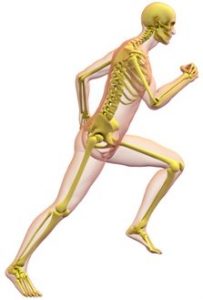The Glutes are likely the most explosive muscle in the lower body. Unfortunately, they are also the one of the most underused. An inactive and underused Gluteus Maximus muscle means that an athlete is unable to push their hip into full extension. Lack of hip extension means poor speed during sprinting movements and/or hamstring injury.
 There is a great deal of misunderstanding regarding the role of the hamstrings. The primary job of the hamstrings is to decelerate the lower leg to control toe placement while sprinting. But, because the hamstrings span 2 joints and can assist the glutes synergistically with hip extension, the situation can become a prime situation for synergistic dominance.
There is a great deal of misunderstanding regarding the role of the hamstrings. The primary job of the hamstrings is to decelerate the lower leg to control toe placement while sprinting. But, because the hamstrings span 2 joints and can assist the glutes synergistically with hip extension, the situation can become a prime situation for synergistic dominance.
Synergistic dominance occurs when a primary mover isn’t performing the action that it is intended to perform, so the synergistic muscle, which is intended to assist with movement and stabilize the joint, ends up taking over as the primary mover. When synergistic dominance occurs, tissue break down is inevitable.
So, poor glute firing can turn a healthy hamstring into a chronically injured hamstring. The key to preventing this? Simple…train the glutes.
 Always perform squatting movements to below parallel (research shows that if an athlete doesn’t break parallel, their glutes don’t fire).
Always perform squatting movements to below parallel (research shows that if an athlete doesn’t break parallel, their glutes don’t fire).
Utilize miniband loops for a number of simple exercises to activate the glute medius and maximus.
And, teach your athletes to always reach full hip  extension during sprinting and acceleration movements with a variety of kneeling, 1/2 kneeling, and standing acceleration type drills. Also, don’t forget to stretch your hip flexors to help your athletes get into extension.
extension during sprinting and acceleration movements with a variety of kneeling, 1/2 kneeling, and standing acceleration type drills. Also, don’t forget to stretch your hip flexors to help your athletes get into extension.
Looking for more help? Schedule a consultation today!


[…] Putting the hamstrings in this position presents a unique injury risk, but it also decreases sports performance because the hamstrings are not as powerful as the gluteus maximus. […]